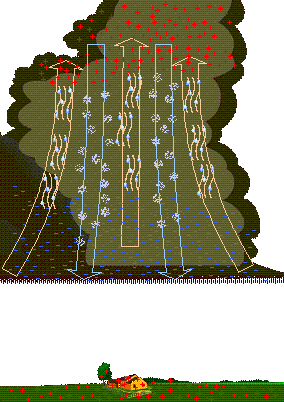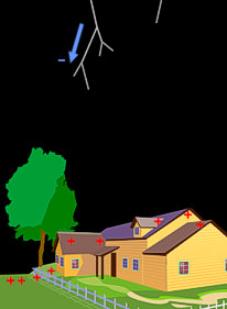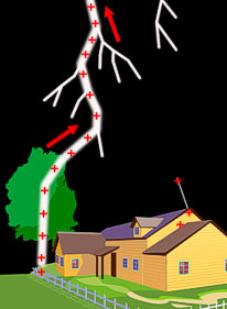Lightning
Lightning is the process of Dielectric Breakdown in nature. Please refer to the Text Panel of the Exhibit Jacob's Ladder for more information about Dielectric Breakdown.
Air is a very good Insulator that inhibits Electric Current to flow. For Lightning to occur, a tremendous amount of opposite charges has to build up on the Storm Cloud and the Earth Surface.
Thunderstorms are created in very turbulent environments in which strong Updrafts and Downdrafts occur. The Updrafts transport small Water Droplets from the lower regions of the Storm to the higher regions, at which the droplets freeze to form semi-frozen water droplets known as Soft Hail, Figure 1. Meanwhile, Downdrafts transport the Soft Hail from the upper regions of the Storm to the lower regions, at which the Soft Hails become water droplets again. The whole cycle repeats.
 Figure 1: Updraft, Downdraft and Accumulation of Charges
Figure 1: Updraft, Downdraft and Accumulation of Charges
The rising Water Droplets and the falling Soft Hail collide. Electrons are taken off from the Water Droplets and are transferred to the Soft Hails. Because Electrons carry a Negative Charge, the result is a Storm Cloud with a Negatively Charged Base and a Positively Charged Top.
Below the Negatively Charged Storm Base, Positively Charged Particles begin to accumulate on the Surface of the Earth, especially on taller objects such as trees, building roof; etc.
An invisible channel of Negative Charge, called a "Stepped Leader", will descend from the bottom of the Storm toward the Ground in a series of rapid steps, Figure 2a.
When the "Stepped Leader" approaches the tall object on the Ground, the Positive Charges "reaches" out to the approaching Negative Charge with its own channel, called a "Streamer", Figure 2b and 2c. When these channels connect, the resulting electrical transfer is what we see as Lightning.
 (a)
(a)
 (b)
(b)
 (c)
(c)
Figure 2: The Process of Lightning
Links
About CMM
Contact US
Others
Other Websites
Number of Visitors:
Last Modified Date: 10/3/2025